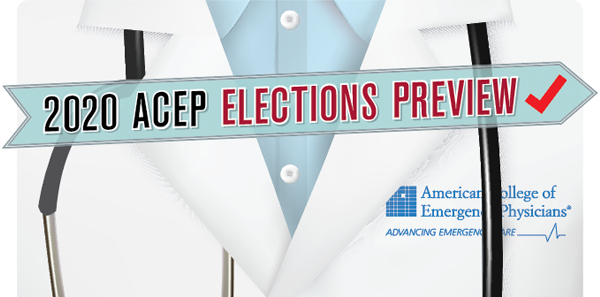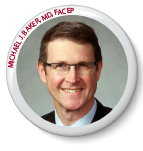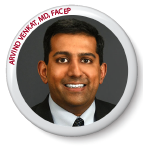
The candidates discuss major issues facing emergency medicine
Explore This Issue
ACEP Now: Vol 39 – No 09 – September 2020Each year, ACEP’s Council elects new leaders for the College at its meeting. The Council, which represents all 53 chapters, 39 sections of membership, the Association of Academic Chairs of Emergency Medicine (AACEM), the Council of Emergency Medicine Residency Directors, the Emergency Medicine Residents’ Association (EMRA), and the Society for Academic Emergency Medicine, will elect the College’s President-Elect and four members to the ACEP Board of Directors when it meets in October. This month, we’ll meet the Board of Directors candidates.
Michael J. Baker, MD, FACEP (Michigan)
 Current Professional Positions: director of telehealth, EPMG/Envision; medical director, Munson Healthcare Cadillac Hospital, Cadillac, Michigan; clinical assistant professor, Michigan State University College of Osteopathic Medicine, East Lansing; ED informatics representative on the clinical excellence committee and chairperson for optimizing information technology, Trinity-Health; adjunct clinical instructor, University of Michigan College of Medicine, Ann Arbor; core faculty, University of Michigan/St. Joseph Mercy Hospital emergency medicine residency; attending physician, member of the telemedicine clinical quality committee, and Cerner physician liaison, St. Joseph Mercy Hospital, Ann Arbor
Current Professional Positions: director of telehealth, EPMG/Envision; medical director, Munson Healthcare Cadillac Hospital, Cadillac, Michigan; clinical assistant professor, Michigan State University College of Osteopathic Medicine, East Lansing; ED informatics representative on the clinical excellence committee and chairperson for optimizing information technology, Trinity-Health; adjunct clinical instructor, University of Michigan College of Medicine, Ann Arbor; core faculty, University of Michigan/St. Joseph Mercy Hospital emergency medicine residency; attending physician, member of the telemedicine clinical quality committee, and Cerner physician liaison, St. Joseph Mercy Hospital, Ann Arbor
Internships and Residency: emergency medicine residency, University of Michigan
Medical Degree: MD, Ohio State University, Columbus (1993)
Response
ACEP’s strategic plans revolve around both threats and opportunities. The unpredictability of the COVID-19 health emergency represents a threat to ACEP. ACEP risks losing members to furloughs and burnout. Lower volumes and reimbursement will drive a reduction in the cost of care. Some emergency physicians have experienced a 20 percent wage drop. Cutting CME benefits will drive our members to low-cost options for education. As hospitals cut positions to save money, more work will fall on the physician. Emergency physician positions might be filled with nurse practitioners or physician assistants who must be adequately supervised and trained. ACEP must connect with members and support them in the workplace during this challenging time.
The second threat is the consolidation of insurers, health systems, and physician groups. Although ACEP has faced consolidation in the past, the level experienced today could restrict competition. As insurance carriers face reduced competition, they will force new ways to lower payments to physicians. One example is the ongoing attempts to pass unfair “surprise billing” legislation. Reduced competition among employers raises physician concerns with ensuring fair compensation, quality patient care, due process, and a safe working environment. ACEP’s vision statement declares, “Emergency physicians practice in an environment in which their rights, safety, and wellness are assured.” ACEP leaders can work with payers, health systems, and physician groups to establish fair workplace policies, promote appropriate reimbursement, and encourage competition.
One of ACEP’s most significant opportunities is to create and analyze big data through CEDR, E-QUAL, and EMF-sponsored research. Reliable data can support the adoption of new concepts, such as telemedicine and electronic records improvements. The consolidation of health systems provides opportunities to collect data in a standardized way. For example, I worked to convince a 93-hospital health system to support CEDR reporting for any participating emergency center. Lastly, EMF must be strongly supported in its vital support of independent research efforts and developing future researchers.
ACEP’s other opportunity is to push for insurance reforms. The COVID-19 pandemic demonstrated the value of emergency medicine to the health care system. Our work with disaster preparedness and ACEP’s quick development of COVID resources such as the ACEP COVID-19 Field Guide (acep.org/corona/covid-19-field-guide) stunned many outsiders who portrayed the emergency center as a high-priced place to receive medical care. ACEP can use that realization to push for fair payment, end narrow networks and surprise billing, and identify mechanisms to ensure adequate health care coverage. ACEP continues to push for a fair resolution to the surprise billing issue and advocates alongside state chapters advocacy, emergency physician groups, and other medical organizations. ACEP can re-affirm its commitment to its vision that “All patients have health care coverage that ensures access to emergency services. Legally mandated health care services are fully funded.” ACEP needs Board members who can quickly recognize and respond to new threats and opportunities
Allison Haddock, MD, FACEP (incumbent, Texas)
 Current Professional Positions: assistant professor of emergency medicine, director of health policy: advocacy, assistant director of faculty development, department of emergency medicine, Baylor College of Medicine, Houston
Current Professional Positions: assistant professor of emergency medicine, director of health policy: advocacy, assistant director of faculty development, department of emergency medicine, Baylor College of Medicine, Houston
Internships and Residency: emergency medicine residency, University of Michigan, Ann Arbor
Medical Degree: MD, Cornell Medical College (2007)
Response
ACEP has 41,435 members, and while our membership is growing, our rate of growth is declining. The growing number of EM residencies in the United States has brought an increase in our candidate membership, but we are seeing a drop in the percentage of graduating residents who retain their membership. ACEP must ensure that we are the premier source of opportunities—for networking, education, and personal development—for emergency physicians. We must demonstrate that we share our members’ values and are advocates for them and their most vulnerable patients. While some will dedicate the time and effort required to be councillors and committee members, we must also offer smaller innovative opportunities for members to get involved with issues that are critical to them personally to support their growth as educators and advocates. As a Board member, I have been involved in our efforts to trial new membership models that meet member needs at every career stage. The picture isn’t grim—our overall membership is still up 5 percent this year—but we should embrace this opportunity to ensure that residency-trained emergency physicians look to ACEP first as an advocate for them on the front lines. We must show our members that we are not afraid to put the needs of the individual emergency physician first—advocating for physician-led teams with no absentee chart signing when working with NPs and PAs, and paid parental leave for EPs—while maintaining a viable emergency medicine practice and fighting external threats to our livelihood like “surprise billing” legislation that allows insurers to set arbitrary and unviable reimbursement levels and persistent insurer downcoding while we provide critical services.
As we lead the front lines in the fight against COVID-19, the eyes of the country have been drawn to emergency physicians. For ACEP, this has presented an opportunity for us to serve as a critical clearinghouse of information, including the COVID-19 Field Guide and the EngagED coronavirus community. Our staff has done an incredible job of finding and sharing resources, like free hotel nights and meals, as we have balanced our dedication to our patients with the threat to our families. However, some of ACEP’s core activities have been put at risk by COVID. We offer robust online educational offerings, but our premier educational and social event has always been an in-person annual meeting. As the Board Liaison to the Education Committee, I have helped convert our annual meeting into an “UnConventional” experience that will offer unique educational and networking moments. To protect us from the threat of COVID in our EM practice, the College has advocated tirelessly for more resources for us—for more PPE, liability protections, hazard pay, and adequate insurance coverage for patients seeking COVID-related care. COVID has brought an immediacy to our advocacy efforts and reminded legislators of the critical role that we play in the health care system.
Aimee Moulin, MD, FACEP (California)
 Current Professional Positions: associate professor, department of emergency medicine, department of psychiatry, University of California at Davis Medical Center
Current Professional Positions: associate professor, department of emergency medicine, department of psychiatry, University of California at Davis Medical Center
Internships and Residency: emergency medicine residency, LAC+USC Medical Center, Los Angeles
Medical Degree: MD, University of Southern California Keck School of Medicine, Los Angeles (2003)
Dr. Moulin has withdrawn her candidacy for the ACEP Board of Directors.
James L. Shoemaker, Jr., MD, FACEP (declared floor candidate)
 Current Professional Positions: director of quality, director of compliance, partner, and attending emergency physician, Elite Emergency Physicians, Inc.; volunteer clerkship faculty, Indiana University School of Medicine, South Bend
Current Professional Positions: director of quality, director of compliance, partner, and attending emergency physician, Elite Emergency Physicians, Inc.; volunteer clerkship faculty, Indiana University School of Medicine, South Bend
Internships and Residency: emergency medicine residency, Michigan State University/Kalamazoo Center for Medical Studies, Kalamazoo, Michigan
Medical Degree: MD, Indiana University School of Medicine, Indianapolis (2004)
NOTE: Dr. Shoemaker declared his intent on Sept. 18 to seek nomination as a floor candidate. His nomination will be formally presented to the Council on the first day of the Council meeting.
Response
There may never be a more important time for ACEP than now. COVID-19 was an unexpected cessation to life as we knew it that will have negative reverberations for an unknown amount of time. Clearly, the landscape of life “pre-pandemic” has been greatly changed. It is essential that ACEP use this opportunity to highlight that emergency medicine physicians do wear the white hat and are essential frontline heroes. This can serve as a catalyst to ensure funding is available for preparedness and for those presenting to the ED and to ensure frontline heroes have stabilization of their livelihoods and jobs. The paradoxical decrease in ED patient volumes and stoppage of hospital elective procedures from COVID-19 in many areas initiated a negative and cascading domino effect of less revenue which led to furloughing of essential workers and job losses for some of our colleagues. We need do better. We must do better. It is clear that the public view of our specialty and the house of medicine has never been stronger. Let’s use this to our advantage. I am ready, willing, and able to do this with my unbiased voice that is free from outside pressures. Now is the time to lobby Congress for repeal of budget neutrality to prevent further cuts to our reimbursement and negate recent successes at the RUC, to have a method for making physicians whole financially and with appropriate tools and gear needed to perform their jobs safely. The optics are in our favor and we need to use this potential silver lining from the COVID-19 pandemic to protect us from the next unexpected event.
One of ACEP’s greatest threats is the full-on assault to erode and decrease our reimbursement. The College has amazing staff, volunteers, and lobbyists in this arena, but we will need to continue to do more collectively. We all took the Hippocratic Oath to do no harm and ensure that the patient was always at the center of our care. Insurers take no such oath. In fact, they routinely put profits over patients. One of the greatest aspects of our specialty is treating all who come to us, regardless of ability to pay or other demographic data. We are the true “safety net” in American health care. The development and implementation of EMTALA was done with the intent to prevent patient dumping and to ensure patients were all treated without discrimination. Sadly, insurers are weaponizing EMTALA against physician groups when our colleagues are trying to negotiate contracts in good faith. Prudent layperson standards mean little to the Goliath insurers if they can deny payment and tie us up in disputes over just charges. This year, I primarily authored Resolution 25(20) for the Council to address my concerns over the adverse impact health care insurers have on our livelihoods. The specialty of emergency medicine is robust, and we need to continue to portray the uniqueness of unscheduled care, 24/7/365 availability, and the value of an emergency medicine residency-trained physician caring for our loved ones in our emergency departments. I am ready to help lead in the strategic response to these unfair and unscrupulous health care insurer behaviors. I will work to help colleagues understand why we are stronger together.
Aisha T. Terry (formerly Liferidge) MD, MPH, FACEP (incumbent, Washington, D.C.)
 Current Professional Positions: associate professor, emergency medicine and health policy, and senior advisor, emergency medicine health policy fellowship, George Washington University School of Medicine and Health Sciences, Washington, D.C.
Current Professional Positions: associate professor, emergency medicine and health policy, and senior advisor, emergency medicine health policy fellowship, George Washington University School of Medicine and Health Sciences, Washington, D.C.
Internships and Residency: emergency medicine residency, University of Maryland Medical System department of emergency medicine, Baltimore
Medical Degree: MD, University of North Carolina School of Medicine, Chapel Hill (2003)
Response
ACEP’s greatest opportunity lies in boldly embracing the enormous opportunity to capitalize upon innovative technical advancement and data analytics in order to solidify emergency medicine as a premier leader of health care transformation, ensure the long-term solvency of College operations through non-dues revenue, and create sustainability of emergency medicine practice relative to quality standards and physician payment. ACEP’s clinical registry—CEDR—offers the perfect opportunity by which to accomplish these goals.
CEDR is currently used to collect and submit quality data to the federal government to evaluate emergency physicians’ provision of care. Since its inception in 2015, CEDR has collected data on over 50 million emergency department visits and saved emergency physicians over $300 million in avoided penalties. CEDR has even greater functional capacity, however. If fully optimized, CEDR could also serve as a vehicle for curating robust data, facilitating transformative research, and informing innovation around health care delivery. Strengthening CEDR’s technical infrastructure and diversifying its capacity would also provide the College with the ability to perform data analytics and pursue non-dues revenue by offering highly sought-after, real-time, robust emergency care data. A more widely adopted CEDR would additionally continue to foster high emergency medicine quality standards while protecting emergency physicians from penalties and creating eligibility for bonuses.
ACEP’s biggest threat is passivity as related to firmly defining the identity of our specialty and the roles of emergency physicians. This is necessary to ensure the longevity, growth, and integrity of our specialty. Emergency medicine must be identified as an essential safety-net health care service. Emergency physicians must be clearly named as the lead clinician in the ED and the primary stakeholder in EM practice models. The coronavirus pandemic has magnified for the world what emergency physicians have always known—that is, that EM is absolutely essential and of tremendous value to the entire health care system. As such, emergency care should be compensated accordingly, regardless of patient volumes, and viewed as a prized resource. ACEP now has an unprecedented opportunity to capitalize upon the momentum of the pandemic by insisting that policies and fiscal support structures fairly and durably recognize EM as vital and essential.
As a champion of quality care, ACEP must also be intentional about clarifying the identity of the emergency physician in the clinical setting. While advance practice providers are welcome and indispensable members of the ED team, their intended skill set does not equate to that of a physician, and patients deserve to have their care led and supervised by the clinician with the highest level of competency—an emergency physician. Finally, the role of the emergency physician relative to the management of their practice should be addressed. EM practice models have evolved such that physician autonomy in the decision-making process for the practice has declined. In some instances, this has resulted in a shift away from patient-centered approaches to care. ACEP should study this phenomenon and model options that promote physician-led practice management, without creating excessive burden or risk.
Arvind Venkat, MD, FACEP (Pennsylvania)
 Current Professional Positions: vice chair for research and faculty academic affairs, department of emergency medicine, Allegheny Health Network, Pittsburgh, Pennsylvania; ethics committee chair and ethics consultant, Allegheny General Hospital, Pittsburgh; national director of research, US Acute Care Solutions, Canton, Ohio
Current Professional Positions: vice chair for research and faculty academic affairs, department of emergency medicine, Allegheny Health Network, Pittsburgh, Pennsylvania; ethics committee chair and ethics consultant, Allegheny General Hospital, Pittsburgh; national director of research, US Acute Care Solutions, Canton, Ohio
Internships and Residency: emergency medicine residency, University of Cincinnati College of Medicine/University Hospital
Medical Degree: MD, Yale University School of Medicine, New Haven, Connecticut (2000)
Response
ACEP and our members are at a crossroads. The COVID-19 pandemic accelerated our challenges but also provided ACEP with a window to ensure emergency physicians and our patients have a better future, one where the emergency care system is properly resourced for all who need it.
Our greatest opportunity as a College and as emergency physicians is to capitalize on the public stature earned through the current crisis in order to advocate for a reimbursement system that recognizes our frontline public health role. This is a role we have always fulfilled but now is the focus of public, governmental, and media admiration. We must seize this opportunity to push for direct funding of capacity and readiness at the emergency physician level. We deserve reimbursement for the expertise and preparation we deliver to our patients and our communities when crisis strikes. Having worked in reimbursement advocacy throughout my career and having witnessed how we are often placed on the defensive in debates over balance billing and insurance downcoding, our opportunity is to take our enhanced reputation from the current crisis to advocate proactively for reimbursement for our public health role. To prepare for the next crisis, whether it is the next wave of COVID-19, mass casualty events, or other societal ills that inevitably will present to the ED, we need all payers to compensate us for the patients we are rightly expected to be prepared to care for, not just those who seek our care. The specific ask may take the form of pushing for enhanced RVU attribution for our CPT codes to spread increased reimbursement across all payers or direct federal funding of emergency physicians and their practices, among other strategies. The opportunity to make the ask successfully will never be higher or more appropriate.
Our greatest threat as a College and as emergency physicians is that we will simply return to a reimbursement system nearly entirely based on volume of patients seen. It is unconscionable that, as we are called heroes by the public, our compensation is threatened. This results from a volume-based reimbursement system adversely driving the levels of emergency physician staffing, the role of mid-level providers in our practice, the divisions in our specialty on the scale and types of our practice organizations and their relationship with their constituent emergency physicians, and the personal well-being of our members when forced to work clinically on the thinnest of margins. We must use our enhanced stature from the current crisis to advocate successfully that emergency physicians, as the front line against this pandemic and future public health crises, must be compensated as highly skilled and essential public health professionals. The current reimbursement system based on volume alone divides us, leads to burnout, and jeopardizes the future of our profession and ACEP. This must change.





No Responses to “2020 ACEP Elections Preview: Meet the ACEP Board of Directors Candidates”